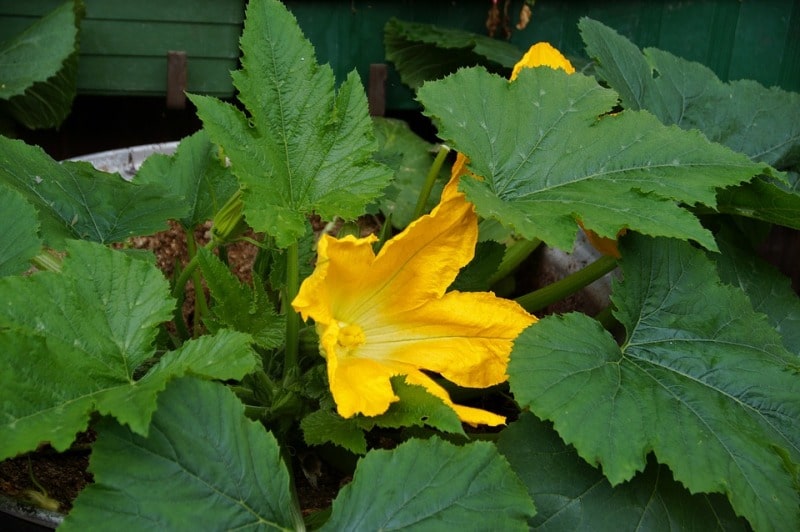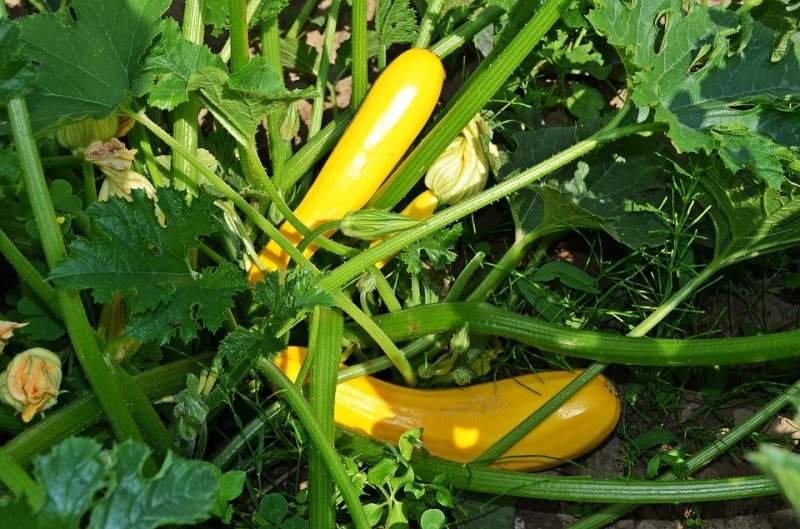A step by step guide for growing Zucchini in containers, Indoors
Today we learn growing zucchini in containers. You can apply the same technique of growing on the terrace, in the balcony, indoors, and backyards. Find the important points of this vegetable.
- A container which has a capacity of 5 gallons has to be filled with a commercial potting mixture of one inch which will contain peat moss, compost, soil, and perlite. Always make sure that you are using a container which has a drainage hole. If there are no holes for drainage, zucchini plants will undergo rotting.
- The potting medium has to be watered in a thorough manner to get settled in the soil. If required, you can also add some more amount of potting medium for replacing the soil which gets settled.
- Follow the instructions which are present on the seed packet to check if the zucchini is a type which needs staking. Zucchini which is of bush type is not required to be staked, but the vine varieties need support for climbing. You will have to put up support like a tomato cage or trellis before the plantation of zucchini.
- The container has to be placed in a spot where it would be able to get sunlight all across the day.
- You can plant at least 5 zucchini seeds at the center of the container. The seeds have to be covered with 1 inch of soil.
- You will have to water them after the plantation. After that, watering can be done as required for maintaining the soil moist, but make sure that it is not soggy. The container has to be monitored on a daily basis mainly at the time of warm climates. Make sure that you are not allowing the soil to dry completely mainly at the time of the first month.
- Zucchini has to be fertilized on every alternate week all across the summer. You can go with the application of balanced fertilizer which is water-soluble and is having an n-p-k ratio of 20-20-20 as per the specifications present on the label. Make sure that you are watering before you fertilize the plants.
- The zucchini seedlings have to be thinned as soon as the germination of seeds takes place. The seedlings which are smaller have to be cut by leaving the two seedlings which are large and intact. When you find that the seedlings have reached a height of 8 inches, you can cut off the seedlings which are weak by leaving behind one seedling in the container. Make sure that the seedling which you are leaving in the container is healthy.
- Do not pull out the seedlings. Instead of pulling them, you can consider snipping them by making use of scissors as the pulling may cause damage to the roots of the zucchini seedlings which are remaining in the container.
- Zucchini has to be harvested when the fruits grow to a length of 6 inches. Based on the variety of zucchini, you can start the harvest in between 1 ½ to 2 months after the germination of seedlings takes place.

Zucchini Plant in Containers.
You may be also interested in Growing Beans Hydroponically.
Facts about growing Zucchini in containers:
- Zucchini plants produce a large amount of harvest by giving rise to the plenty amount of vegetables for many months. Each zucchini plant will be able to produce a minimum of 6 pounds of zucchini across one growing season.
- You can start harvesting the zucchini when it has grown to a length of 4 inches to 8 inches and about 2 to 3 inches in diameter. Usually, zucchini takes 1 to 2 months from the time of plantation to harvest. Zucchini is a fruit which grows quickly that is up to 2 inches a day, so it is always best to consider harvesting them on an alternate day at the time of the growing season.
- Growing zucchini in containers is as easy as growing other gourds or squash.
- Zucchini is a plant which requires full sun, at least for 6 hours in a day. This should be grown in the soil which is moist and is also rich in terms of organic material. Growing zucchini on a trellis is also possible. Some varieties of zucchini are vine types which need a trellis for support or plenty of space for sprawling. There are also zucchinis of bush varieties which are mostly considered for container and balcony gardening.
- A zucchini plant is also prone to a lot of diseases. These consist of bacterial wilt, yellow mosaic virus, powdery mildew, and botrytis blight.
- Zucchinis are the squashes which will grow as annual plants in almost every climatic conditions at the time of warmer months of the year. It will take only two plants of zucchini to give rise to squash which would be sufficient for one family. As zucchini is an annual vegetable, the lifetime of this lasts for the summer and it will continue growing until a part of autumn.
- While you are watering your zucchini, it is always best to water them in a deep manner for one time a week. The plants have to be provided with one inch of water on a weekly basis if there is no rain at all. To know if the plants require watering, you can dig at least 3 inches into the soil beside the plants. If you find that the soil is dry, then it means that it is time for watering.
You may also check the Growing Spaghetti Squash, Planting, Care, Harvesting.
- Though zucchini and cucumber come from the same family of cucurbit, they will not be able to cross-pollinate as they are different species. When you plant them in the same garden and even beside each other, there will not be any decrease in the quality of fruit.
- Sometimes, you see that your zucchini is not growing big. This is mainly caused by a deficiency of calcium, but it may also be due to the irregular watering. Calcium would be able to reach up to the plant when the plants absorb water through the roots.
- Vine borers are the ones which may cause death to zucchini plants. When these vine borers hatch, the larvae will cause yellowing of leaves and zucchini leaves start drying up which would lead to the sudden death of zucchini. If you see that the leaves of your zucchini are wilting, then it is an indication that the vine borers are already on the stem of your zucchini plant. The vine borer’s eggs are usually laid on the lower section of the leaves towards the plant’s base.
- When you are pruning the leaves of the zucchini plant, make sure that you are being careful not to take off all the leaves. Leave some of the leaves on the stem along with leaf nodes which are closer to the last zucchini fruit you want to keep. When you are removing the leaves to provide zucchini with more amount of sunlight, you can just cut the larger leaves and make the cuts near to the plant’s base by leaving all the others.
- By staking zucchini, you will be able to grow them in a less amount of space without any loss in terms of production. As you can see the growth of zucchini along with the production of fruit, you can remove all the leaves which are present in between the fruit and the ground. When the zucchini reaches sufficient length, you can consider tying the vine to the stake.
- Sometimes you see your zucchini plants turning yellow. Plants which are not pollinated in a proper manner will develop less number of fruit or a developed fruit which will become yellow and drops. You can see your zucchini being stunted or misshapen when the rates of pollination are low.
- You can consider growing tomatoes as companion plants for zucchinis. Both of the plants love warm climatic conditions and they also have similar growing methods.
- Beans and squash like zucchini will be the best companions. The plants which would fix nitrogen will benefit plants, mainly the plants like zucchini and squash which are heavy feeders by giving all the nutrients required.
- Downy mildew will lead to the creation of green or yellow-colored spots on the leaves. As you see more numbers of spots, they will grow into one another and will start turning the leaves brown. Moist conditions will cause the lower section of leaves to have growth in purple or white colors. Powdery mildew will cause white spots on your zucchini leaves that gradually turn brown.
- If you find that your zucchini plant has started to flower, but is not producing any fruit, you will have to be patient for a while for the plant to reach the stage of maturity or for the climatic conditions to change. As an alternative, your zucchini plant might require support in terms of pollination.

That’s all folks about growing zucchini in containers, and indoors. Keep gardening.!
You may also like Horticulture Farming; Types of Horticulture.